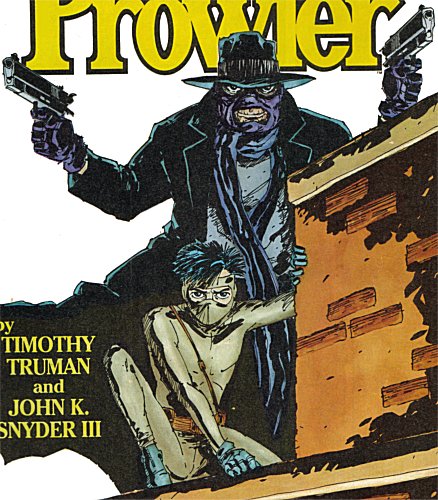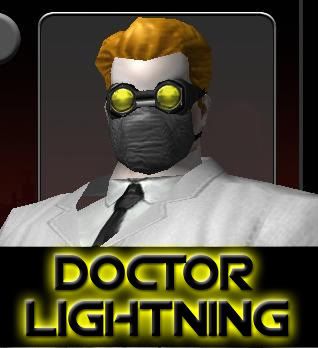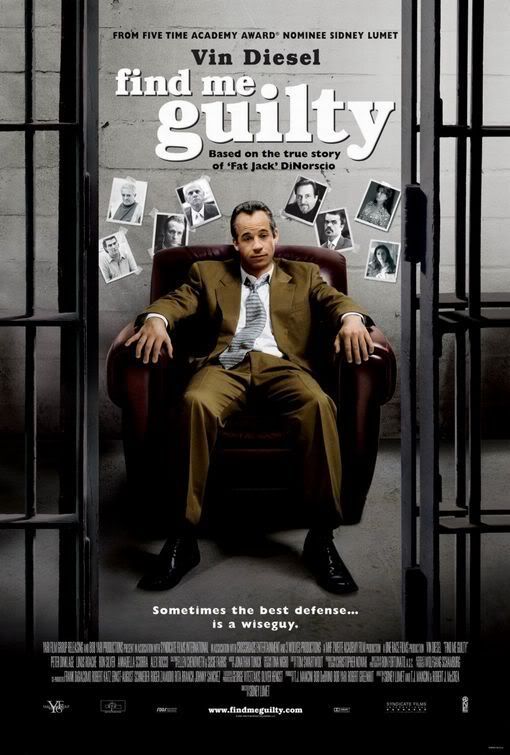

The Pulp Collective is a think tank of pulp fiction fans dedicated to spreading the literary joy that is pulp. Discussions about neo-pulp/noir in movies, books, comics and games will be unleashed unto the unsuspecting public. It is our goal to bring enlightenment and entertainment to the otherwise listless masses. This is Doctor Lightning signing off....



 Attention America, this is Doctor Lightning broadcasting way above Mount Rushmore in my armored airship, the Flying Reaper. I am the master of the skies and none of you can do a thing to stop me.
Attention America, this is Doctor Lightning broadcasting way above Mount Rushmore in my armored airship, the Flying Reaper. I am the master of the skies and none of you can do a thing to stop me.

 It finally lands on Earth and smacks the Detective Chimp knocking the poor guy out. The chimp regains consciousness and uses the helmet to solve all sorts of crimes. Eventually he discovers that for all the good he does with the helmet, there are more problems that come with it and he becomes swamped in trying solve them. He gives the helmet a great kick, a dimensional aperture opens and it disappears. This was an entertaining story with great humor and action. What does one expect from a talking monkey who's a better detective than Batman? Incidentally, the Chimp can be found in the title Shadowpact. Another great supernatural/action comic.
It finally lands on Earth and smacks the Detective Chimp knocking the poor guy out. The chimp regains consciousness and uses the helmet to solve all sorts of crimes. Eventually he discovers that for all the good he does with the helmet, there are more problems that come with it and he becomes swamped in trying solve them. He gives the helmet a great kick, a dimensional aperture opens and it disappears. This was an entertaining story with great humor and action. What does one expect from a talking monkey who's a better detective than Batman? Incidentally, the Chimp can be found in the title Shadowpact. Another great supernatural/action comic. The helmet then appears in Ibis the Invincible. Young Danny Khalifa, using the newfound powers as an avatar of benevolent Egyptian gods, prevents the helmet from being used by Set. A decent story with great old school art. The detail on the Egyptian gods is simply amazing. I think this character is going to have great potential.
The helmet then appears in Ibis the Invincible. Young Danny Khalifa, using the newfound powers as an avatar of benevolent Egyptian gods, prevents the helmet from being used by Set. A decent story with great old school art. The detail on the Egyptian gods is simply amazing. I think this character is going to have great potential.

 Somehow the helmet appears in Sargon the Sorcerer. Now THIS was an issue I **REALLY** enjoyed. The art was incredible, the story of how David Sargent inherited his grandfather's legacy and power was well done. The art had a distinct pulp look to it. The colors are dark yet muted, the inking thick and moody. He stumbles across the Ruby of Life, which his grandfather possessed and was told of his destiny. Using his new magic, he dealt with two humans-turned-demon who tried to bilk him out of his grandfather's estate. The way he deals with the two wizards is amusing and horrifying.
Somehow the helmet appears in Sargon the Sorcerer. Now THIS was an issue I **REALLY** enjoyed. The art was incredible, the story of how David Sargent inherited his grandfather's legacy and power was well done. The art had a distinct pulp look to it. The colors are dark yet muted, the inking thick and moody. He stumbles across the Ruby of Life, which his grandfather possessed and was told of his destiny. Using his new magic, he dealt with two humans-turned-demon who tried to bilk him out of his grandfather's estate. The way he deals with the two wizards is amusing and horrifying. Attention America, this is Doctor Lightning broadcasting deep below the North Pole. I have successfully tamed the Lier in Wait utterly and completely. You will bow down to my whim or I shall unleash Him onto the heartland of your country.
Attention America, this is Doctor Lightning broadcasting deep below the North Pole. I have successfully tamed the Lier in Wait utterly and completely. You will bow down to my whim or I shall unleash Him onto the heartland of your country.
 A quick transmission before I release my robotic Hessians onto those Cossack savages in Russian...
A quick transmission before I release my robotic Hessians onto those Cossack savages in Russian... Attention America, this is Doctor Lightning broadcasting deep within the Ural Mountains in easter Europe. There is no place my airship, the Flying Reaper, can go. I am unfettered by the laws of air, sea or land.
Attention America, this is Doctor Lightning broadcasting deep within the Ural Mountains in easter Europe. There is no place my airship, the Flying Reaper, can go. I am unfettered by the laws of air, sea or land.
 Hi, friends. Don here with my first book review for The Pulp Collective. I barely got the book out of the Miskatonic University Library archives with my life intact, and between the security guards, their dogs, and that... thing they sent after me, I'm lucky to be writing this.
Hi, friends. Don here with my first book review for The Pulp Collective. I barely got the book out of the Miskatonic University Library archives with my life intact, and between the security guards, their dogs, and that... thing they sent after me, I'm lucky to be writing this.In his first novel, "The Chinatown Death Cloud Peril", Paul Malmont weaves together an interesting tapestry of pulp-fact and pulp-fiction. The novel throws a huge handful of pulp writers into a firestorm of a plot involving Chinatown tong wars, biological weapons, a vengeful Chinese warlord, and a shambling, undead H.P. Lovecraft.
It really is (to use a horrible cliche) a roller-coaster of a novel.
It begins with a bet, a story-telling competition between bitter rivals Walter Gibson (writer of The Shadow) and Lester Dent (writer of Doc Savage). Along the way, it snowballs to draw in the writers' significant others, along with a handful of other pulpsters: a mysterious Robert Heinlein, a cocky young L. Ron Hubbard (who, surprisingly, was my favorite character), E.E. "Doc" Smith (and his doughnuts), and a gun-slingin' Louis L'Amour. The book's relentless pace and ever-expanding cast leaves the reader a bit breathless, but always wanting to read "just one more chapter."
Many pulp-fans have complained that many of the "facts" in the book were changed or invented. I'm not one of those complaining fans, although the fabrications do stick out like a sore thumb if the reader is "in the know." C'mon, though: it's a really fun ride, and a true pulp fan should be able to set aside those fabrications and just enjoy it. I give this book my highest recommendation.
(PS: The book just came out in it's paperback form, so you can pick it up for cheap. Also, I've exchanged a few emails with the writer, and he's indicated there may be a sequel in the works! Stay tuned...)

 (now how do I turn off this thing...)
(now how do I turn off this thing...)
 Welcome friends and agents of the Pulp Collective... This is Doctor Lightning broadcasting from the depths of the Atlantic ocean from my submersible armored zeppelin, the Flying Reaper.
Welcome friends and agents of the Pulp Collective... This is Doctor Lightning broadcasting from the depths of the Atlantic ocean from my submersible armored zeppelin, the Flying Reaper.THE NEOPULP MANIFESTO (v.2)
(revised 21/12/2006)
Contents
1. To Begin With
2. Concerning Etymology
3. Furthermore
4. Some Attempts at Definition
5. Serving Suggestions
6. Fine Tuning
7. In Conclusion
8. NeoPulp salutes those who have paved the way![]()
1. To Begin With:
NeoPulp is not a new style of writing. It is a fusion of several well-tenured styles of writing.
NeoPulp draws liberally from the fantastic stories of this and previous centuries, a melange of mythology and popular culture (take a bit of Godzilla, a bit of Paradise Lost, some giant robots, the sexual tension of a romance novel and the Bhagavad-Gita and mix them all together), and adds to this a “literary” understanding of characters’ motivations and emotional needs.
NeoPulp embraces the clichés of pulp writing: the naïve superscience of B-movies, the nefarious underworld criminal mastermind, the lone sheriff against a town of outlaws, the young woman torn between love for a mysterious stranger and respect for her fiancée, and the mad god bent on destruction, and examines them closely in an attempt to find - or try - something novel: a subversion, an inversion, a juxtaposition, a statement about the human condition.
NeoPulp is born of a love and admiration for the flawed nature of pulp culture; it is not an exercise in poking fun at the plot and character shortcomings that are endemic to pulp. Such things are obvious and have been done to death. Rather, NeoPulp attempts to create a real and sympathetic portrait of these bizarre and self-contradictory characters and situations.
NeoPulp fuses the legacy of romantic, realist, post-modern and modernist writing with popular culture entities such as B-movies, comics, television, pop music and airport novels.
NeoPulp places realistically-defined characters into fantastic situations. It avoids the two-dimensional characterisation of pulp fiction while embracing every aspect of its subject material.
NeoPulp takes what is great about pulp fiction - the action, the sense of adventure and danger, the exploration of strange and fascinating ideas - and combines it with what is great about contemporary fiction - sophisticated understanding of characterisation and an awareness of and a willingness to draw upon literary history.
NeoPulp stands opposed to the tendency to pigeonhole writing as one or another kind of genre or sub-genre.
NeoPulp is not restricted to one medium. NeoPulp occurs in poetry, short stories and novels alike. It occurs in comics, song lyrics, movies and television. NeoPulp transcends genre boundaries; it likewise transcends boundaries of medium.
NeoPulp lacks the po-faced portentousness of contemporary genre fiction.
NeoPulp is fun without being stupid.
NeoPulp is not aimed at a specific demographic.
NeoPulp is for anyone who enjoys reading.
2. Concerning Etymology:
The “Neo” of NeoPulp refers to NeoPulp’s tendency to use distinctive elements of contemporary popular culture. This is not to say that NeoPulp can only be set in the present. It is merely to imply that the sensibilities of NeoPulp tend toward the contemporary.
The “Pulp” of NeoPulp acknowledges the progenitors of this kind of writing: the authors who have worked within various genre fields and gone largely unacknowledged by people other than highly specialised groups of fans.
3. Furthermore:
It is a widely acknowledged fact that all manifestoes contain within them a series of outrageous and dubious claims. Here then is such a claim that may be freely associated with NeoPulp:
"The current trend toward 'realist' fiction has created a reading public who simply look for the most accurate reflection of themselves in what they read. They hold a mirror to themselves with the books that they choose. This is an intolerably narrow standpoint. NeoPulp challenges the idea that this is all that people want. It stimulates the imagination and the sense of adventure, the sense of humour, the sense of fun, the sense of amazement in a way that is beyond the capabilities of 'realist' fiction."
Another requisite element of manifestoes is a somewhat pompous and slightly incoherent rant about the purpose and future of the movement:
“NEOPULP IS NOT REALISM. IT IS UNREALISM, OVER-REALISM, COUNTER-REALISM. NO LONGER SHALL THERE BE ONE BOX FOR ACCURATE REALISM AND ANOTHER FOR UNREAL DEPICTIONS - THE LIKES OF FANTASY, SCIENCE FICTION, ROMANCE AND REALISM ALL COME TOGETHER UNDER THE NEOPULP BANNER.”
4. Some Attempts at Definition:
The most important clarification is to point out what NeoPulp isn’t. This will allow an understanding of what NeoPulp is.
• NeoPulp is not horror, although elements of horror are present in NeoPulp, such as zombies, vampires, serial killers and haunted houses.
• NeoPulp is not fantasy, although elements of fantasy are present in NeoPulp, such as magic, Gods, mythological characters and certain character archetypes such as the warrior and the wise man.
• NeoPulp is not science fiction, although elements of science fiction are present in NeoPulp, such as advanced technologies (eg robots, cloning, teleportation devices) and alien races.
• NeoPulp is not realism, although elements of realism are present in NeoPulp, such as sophisticated portrayals of the psychological profiles of characters depicted, and aspects of the mundane world (eg the need for employment, desire to be entertained, governmental restrictions, a narrative understanding of the consequences of actions…)
• Most importantly, NeoPulp is not satire. The subject matter which NeoPulp draws from is undeniably flawed in many ways. To point out these flaws would be an easy and redundant matter. Instead NeoPulp attempts to respond to these flaws in a different way, utilising them as the underpinning of a re-interpretation of pulp fiction conventions that is sympathetic to its protagonists, rather than cynical, critical or dismissive.
5. Serving Suggestions:
NeoPulp draws on various sources for its iconography and archetypes, including (but not restricted to) comics, pop-songs, mythology, B-movies, epic poetry, cartoons, romance novels, westerns, television and fairytales. The following are examples of NeoPulp archetypes.
a) The goddess suffering an existential crisis.
b) Philosophical musings of the radioactive dinosaur.
c) The robot in love with the evil robot it was designed to destroy.
d) The internal politics of a superhero team.
e) The childhood reminiscences of the astronaut monkey.
f) The broken-hearted ex-sheriff with a time machine.
g) Frankenstein runs for President.
h) Vishnu joins the space program.
i) The ex-commando private eye is diagnosed with cancer.
These are not held up as proscriptive examples, merely a taste of what is possible within the ambit of NeoPulp (see point 8, "NeoPulp salutes those who have paved the way" for more examples).
6. Fine Tuning
Since its inception, NeoPulp has encountered several well-meaning misinterpretations of its fundamental characteristics. The following are intended to correct common misconceptions regarding whether or not a piece of writing is truly NeoPulp:
• NeoPulp always contains a significant amount of recognisable, tangible elements drawn directly from the contemporary culture of the authors of NeoPulp stories.
• NeoPulp is more than the simple name-dropping of obvious popular culture icons for the sake of humour or nostalgia. A key element of NeoPulp is a considered and creative approach to the consequences of the structural inadequacies of pulp writing.
• NeoPulp is not deliberately constructed as an allegorical story-telling form. Thinly-disguised concepts that "stand in" for contemporary social situations are unnecessary in NeoPulp. The social situations themselves can be used in NeoPulp stories.
• It is acknowledged that NeoPulp bears a striking resemblance to postmodernism, but its dialectic is more concerned with the interplay between "high" and "low" culture than it is with the interplay between the past and the present.
7. In Conclusion:
It should be pointed out at this time that, as with most manifestoes, the use-by date on the NeoPulp Manifesto is rather close. By the time the reader reaches this point of the NeoPulp Manifesto, the manifesto itself will have become obsolete.
8. NeoPulp salutes those who have paved the way.
The writers of the following texts are presently unaware of the existence of the NeoPulp manifesto. Many of these texts predate the manifesto's existence. Regardless, the following is a list of exemplary NeoPulp writing, to be used as a benchmark indicating the form's potential.
books
• Steven Sherrill - The Minotaur Takes a Cigarette Break
• Michael Moorcock - The Cornelius Quartet
• Kirstin Bakis - Lives of the Monster Dogs
• Earl Mac Raunch - Buckaroo Banzai
• Jan Lars Jensen - Shiva 3000
• Stephen Dobyns - Heat Death
comics
• Ben Kooyman - Hamlet vs. Faustus (new addition)
• Matt Fraction and Gabriel Ba - Casanova (new addition)
• Alan Moore – League of Extraordinary Gentlemen
• Elizabeth Watasin – Charm School
• Warren Ellis – Planetary
• Grant Morrison - The Invisibles
• Ann Nocenti - Longshot
• Jill Thompson - Scary Godmother
• Benjamin Birdie - Genre City
(Doctor Lighting -What nonsense... music?)
music
• The Flaming Lips – Yoshimi Battles the Pink Robots
• The Buggles - The Age of Plastic
• Devo - Duty Now for the Future (esp. "Secret Agent Man" & "Smart Patrol")
• Laurie Anderson - Mister Heartbreak
• Batboy the Musical
film and television
(Doctor Lightning - Buffy? Bill Murray? I think not. Though his film The Man who knew too little would be much more appropiate)





 Greetings America, this is Doctor Lightning founder of the Pulp Collective.
Greetings America, this is Doctor Lightning founder of the Pulp Collective.